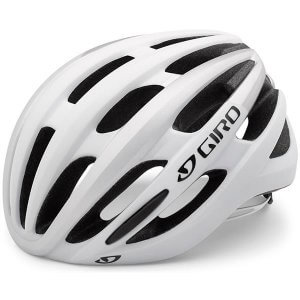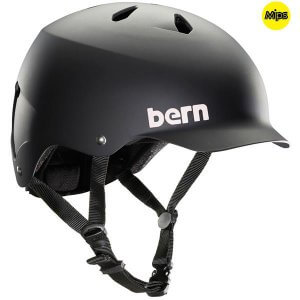When it comes to bicycling in today’s society, safety gear is the most important thing to consider, and no piece of equipment is more vital than the bike helmet. Designed specifically for protecting a bicyclist from severe head injury, great care should be taken in learning about the different kinds of helmets, including what new bike helmet technology exists today and the proper bike helmet care to ensure a long-lasting product. This complete buying guide will help bicyclists determine which type and style of helmet is best suited to their needs.
How to Choose a Bike Helmet
In selecting a new bike helmet, there are a number of features to consider in looking at the different types of bike helmets. We’ll look at each of them separately to determine how each feature will affect your decision and lead you to the helmet that will afford you the best level of protection.
One of the first considerations in understanding how to buy a bike helmet concerns the type of biking you’ll be doing. Certain biking activities like mountain biking require greater protection than others. There are specific helmets for every activity, just as there are specially designed helmets for each type of bike rider, so selecting the first helmet that catches your eye could be a perilous mistake. For example, considering a helmet for a road bike would require much less protection than a helmet for a mountain bike for some intense downhill mountain biking.
As far as riders go, different age groups necessitate the use of greater cranial protection. Obviously, small children require greater protection, but, today, helmets are designed to give the best possible protection for every age group.
Toddler – Children under the age of 5 fall under this category and, because their skulls are still soft and underdeveloped, they require greater padding and support. The helmet is usually round and smooth with extra support for the rear of the head. Children under 5 should be provided with a child seat that provides support for the head, as the additional weight of the helmet may make it difficult for them to continue sitting upright.
Children Between 5-10 – Helmets for this age group vary and can include helmets similar to those worn by toddlers. They can also utilize styles designed for road use by adults. Generally, children of this age group can wear any bike helmet that fits, regardless of what the age tag may suggest.
Youths Up to 15 – Teens in this age group should use either a road or mountain bike helmet, designed specifically for the age group. Graphics on the exterior of these helmets make them easy to identify. These helmets are made from EPS foam with a vented plastic shell.
Women’s Road Helmet – These helmets are specifically designed for women with longer hair, providing a port at the rear for a ponytail or long hair worn similarly. In past decades, there were helmets of this nature designed for men as well, but the fad of long hair on men has faded, taking these helmets with it. As far as fit, there has been no observable difference between the size and shape of a woman’s head as opposed to that of a male rider.
Road Bike Helmet – The most widely used helmet in the world, these are the elongated shapes with the EPS foam and plastic shell. Vented for airflow and usually designed with for roads and road racing. Aero Road Helmets are designed with greater attention to racing. In addition to an aerodynamic design, Aero helmets often have multiple vent ports to increase airflow and comfort.
Mountain Bike Helmets – Mountain bike helmets are designed to ventilate well at low speeds and are often distinguished by small visor. They have enhanced rear-head coverage and a firm and a secure fit for tackling rough terrain. Mountain bike helmets are often used by cyclocross riders, too.
Commuter Helmets – This helmet deviates from the elongated shape to provide a rounder fit, but is generally constructed in much the same manner as the previously mentioned road helmet. The commuter bike helmet construction can sometimes vary with the addition of mirrors, ear flaps for wintry weather, and rear turn signal blinkers.
Downhill Racing – This is a sturdier helmet not far removed from the motorcycle helmet. This helmet features a chin bar to provide greater protection to the jaw and face. While these helmets are also constructed with EPS foam and vented plastic shells, so brands utilize stronger shells, such as those made from fiberglass or carbon fiber.
BMX Helmets – Helmets for BMX (Bicycle Moto-Cross) riders can vary from the very lightweight construction of the road helmet to fully protective motorcycle style helmets. These helmets rarely have vents, due to the short duration of most BMX races. Some helmets in this category only conform to ASTM F 2032 BMX bicycle helmet standards, while others comply with the stricter guidelines set forth by the Department of Transportation.
Chrono Helmets – These helmets have an odd elongated teardrop shape and are used mostly in time trials. The main goal with these helmets is to enhance aerodynamic efficiency for bike racers and they generally lack vents. Many do come equipped with a long tail that can extend down the rider’s back, causing the tail to jerk the rider’s head in an accident. Many racing organizations have requested that bike helmet construction be modified to protect against impacts.
Bike Helmet Technology
The next step in determining how to buy a bike helmet is to look at the way technology has affected the construction of helmets. Currently, the big thing in bike helmet safety is MIPS (Multi-directional Impact Protection System), which was first introduced in Sweden. The MIPS helmet contains a small, thin liner inside the helmet that helps the outer shell to shift or rotate upon an impact, reducing the rotation applied to the head and also reducing the force transferred to the skull.
Does it work? At this time, the effectiveness of MIPS to prevent concussions can’t be determined, because there’s currently no objective test for diagnosing these types of head injuries. Concussions are diagnosed through a set of symptoms and a neurological exam. Future studies may indicate if a MIPS helmet can prevent concussions, but they do seem to provide added protection, so they may still be worth the cost.
An even newer technology is making a dent in the different types of bike helmets hitting today’s market. AIM (Angular Impact Mitigation) helmets replace the standard EPS foam liners with a honeycomb pattern. Like MIPS, the inner liner shifts to deflect the force of an impact from the skull, while the honeycomb pattern also works to absorb the force of the blow. Studies have shown a 14% less linear acceleration of the head on impact, while also showing a 34% rotational acceleration.
Bike Helmet Sizing
Selecting a helmet is an important decision and once you add one to your inventory of safety equipment, the hope is that it will last you for many years. To get started, however, bike helmet sizing is a vital step in selecting the best product. Using a helmet that isn’t a good fit may be just as bad as wearing no helmet at all, so you want to be sure you’re wearing the size most appropriate for your measurements. Generally speaking, the ideal is to select a helmet that provides a snug and firm fit that will stay aligned with your head, during movement.
The first step, of course, is to measure yourself, so you can go shopping with your exact measurements in mind. To do this, measure the circumference of your head with a tape measure by running the tape around your head, just above your ears. The tape should remain at mid forehead level, just about one inch above your eyebrows, as this is where the brim of the helmet will fit. It’s suggested that you measure two or three times and take the largest of the three measurements as your best fit.
In the event that you can’t get your hands on a tape measure, you can use a string and measure it against a ruler or a yard stick.
Whichever method you use, be sure to write down your measurement, so you can be accurate in selecting the right size. Also, if you find that your exact measurement falls between sizes on the bike helmet size chart, round up to the next higher size.
Bike Helmet Size Chart
- 18.5 inches (47 cm) – 20.5 inches (52.1 cm) – toddler
- 20 7/8 inches (53 cm) – small
- 21 1/4 inches (54 cm) – 22 3/8 inches (56.8 cm) – medium
- 22 3/4 (57.8 cm) inches – 26 1/8 inches (66.3 cm) – large
There are larger sizes available for those people with measurements beyond 26 1/8 inches (66.3 cm), but they may have to be special ordered. In the case that you require an oversized helmet, don’t settle for a smaller one that fits poorly. Your safety is dependent upon acquiring the correctly proportioned helmet, even if it means waiting a little longer to get on the road with your bike. The importance of accurate bike helmet sizing cannot be stressed enough.
The next step is to try on the helmet you’ve selected to ensure a good fit. The helmet should sit firmly on your head without shifting or moving. Turn your head from side to side and nod back and forth to be sure of a snug fit. In the event that you have selected the closest fit for your measurements, consider inserting additional padding to ensure a better fit. It also may help to try a different brand of helmet, as some manufacturers’ sizes may vary slightly, due to helmet design.

Additional tips for selecting a good helmet include selecting a helmet that sits above the eyebrow line and doesn’t make contact with the nape of your neck. Also, the chinstrap should feel firm, but shouldn’t give you a choking sensation. If this is the case, the strap needs loosening, though still be sure the helmet stays in place during movement. If you can feel the skin of your forehead move, this is an indication that you have chosen a good fit.
Bike Helmet Features and Specs
Compare the specs of various helmets using the guide below. Determine which attributes are most important or most relevant to your style of riding.
- Weight: Weight is almost always listed in grams (28.34g = 1 oz.). Racers and frequent cyclist will appreciate the weight savings of a lighter helmet. For occasional cyclist, weight is not a big concern. The lighter the helmet, the more expensive.
- Vents: Vents are designed to create airflow around and over your head and will cool the head. The more vents, the pricier the helmet.
- Visor: Some riders prefer having a sun-shielding visor attached to their helmet. On the flip side, it adds a fractional ounce of weight and slight wind resistance.
- Fit system: Manufacturers create a variety of names (e.g., Roc Loc, GPS, Acu-Dial) to represent their approach to a helmet’s sizing wheel (typically a dial). Be sure to visit the manufacturer’s website for a detailed explanation.
Bike Helmet Care
This section is designed to not only teach you how to best care for your new helmet, but also to help you determine when to replace a bike helmet. These are important factors in helping you stay safe, while enjoying your biking activities. The goal is to keep your helmet in peak condition for as long as possible, so it’s recommended that you act diligently in following the recommended guidelines for caring for your helmet.
There are common practices that people unknowingly employ in cleaning their helmets that can end up destroying or damaging them. Among them are the use of chemical cleaners, soaking in baths, the use of extremely hot water, and washing them in dishwashers. These practices can affect the structural integrity of the helmet, making it far less effective in the event of an accident or crash.
Chemicals may break down the foam barrier inside the helmet, for example. Also likely is the possibility that hot water and soaking in a bath may cause the adhesives used to bind the foam to the shell to loosen or dissipate.
What you can do is wipe the exterior of the helmet down with a moist cloth to rid it of dirt, mud, and grease. This will keep the outside of the helmet looking fresh and new without risking irreversible damage or compromising the effectiveness of the helmet.
For a deeper clean, when the inside of the helmet requires some freshening up, a little shampoo can go a long way. Using your fingertips, rub shampoo into the padding until you feel as though you’ve covered the entire helmet. Next, rinse thoroughly with lukewarm water. It’s important to make sure you get all of the shampoo out, or you might find it stinging your eyes the next time you’re out riding on a hot day. Finally, dab dry with a soft towel and allow to air dry, prior to your next use.
Helmet padding is removable, which may come in handy as the pads begin to wear over time. When that happens, there’s no need to replace the entire helmet. Just stop by your local bike shop and inquire about ordering replacement pads. Some specialty stores may even keep a selection in stock for the more common helmet sizes.
One word of warning about modifying your helmet: don’t! While it may seem like a good idea to add accessories, such as a camera at the rear of the helmet, fastening devices could interfere with the integrity of the helmet and decrease its value as a safety device. It’s recommended that you refrain from adding anything to your helmet, other than reflective stickers to make you more visible in evening hours.
So, how do you know when to replace a bike helmet? You should be conducting regular safety inspections of your helmet, which is also something you can do each time you wash it. Run your eyes over the inside and outside of your helmet in search of small cracks or fissures forming in the plastic casing. In addition to regular checks, you should also do this after a fall or crash, even if you don’t think you hit your head.
Suppose you do see a hairline crack? In that case, try to pull the helmet apart with your hands. If you see even the slightest indication that the crack is widening, it’s time for a new helmet.
Other signs that you need a new helmet can be found in the exterior side of the casing. Look to see if the shell is cracked or deformed in any way. Sun damage may also make it necessary to buy a new helmet, as that may indicate a softening of the material.
Aside from finding damage or experiencing a crash in which the helmet is visibly damaged, bike safety experts recommend replacing a helmet every two years. This ensures you’re not riding with a compromised helmet, but it also allows you to benefit from the latest technological advances in helmet production and safety. New products hit the market everyday and helmets continuously go through revolutions that make previous versions seem obsolete.
These insights into choosing the proper helmet may give you the knowledge needed to make a wiser choice and ensure that you have years and years of safe and enjoyable bike riding activities. Many bike shop owners are experienced riders in their own right, so don’t hesitate to direct future concerns toward them, while shopping for your new helmet. They may also be able to assist in choosing the helmet best designed for your activity and experience level. While a helmet won’t guarantee you’ll never suffer a head injury, having the right one will go a long way towards limiting injuries in degree and frequency. In combination with safe riding practices, protective gear can make a difference.














[…] the specs of various helmets using the guide below. Determine which attributes are most important or most relevant to your style of […]
I buy helmet that has a soft foam. Some the helmets surface are hard and can cause headache.For this particular reason I don’t buy hard helmets. Although they are more safe but, riding for a long period of time with those helmets gives a really bad headache. Thanks for this post. very helpful.
[…] from any serious injuries whenever you fall, tumble, or crash. It’s important that you find the perfect fit for you, as a helmet that’s too big or too small won’t properly serve its […]